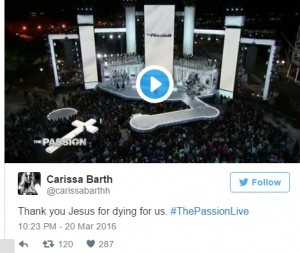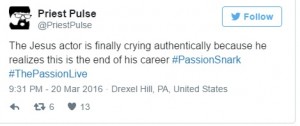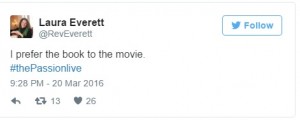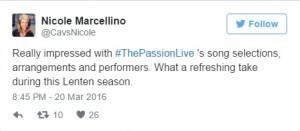On Palm and Passion Sunday, Tyler Perry’s Passion went live. It was, by many accounts, a blockbuster. Not all reviews were uniformly positive, however.
Twitter was full of superlative praise for the 2-hour long show, setting the Passion of Christ in contemporary New Orleans.
Not everyone was impressed.
The Religion News Service review criticized the use of familiar music instead of original material.
…to be accurate, “The Passion” was only live in part; most of the story segments appeared to be pre-filmed and, it seems, pre-sung.
Still, as familiar as those forms might be, it’s doubtful many of us ever thought we’d see them mashed together into one semi-live, Jesus-jukebox musical — hosted and narrated by Tyler Perry from a New Orleans stage on the banks of the Mississippi. Nor did we expect to see one of mankind’s greatest stories, a tale and event that launched one of the world’s great religions, reduced to broad, borrowed pop-song bromides. It was well-sung, to be sure; it just wasn’t well thought out.
Rather than use original music, “The Passion” tweaked the lyrics to old favorites, often to odd effect. Chris Daughtry’s Judas singing “Wake Me Up Inside” might have conveyed the suffering of a man in turmoil (as Perry spelled it out for us as soon as the song ended), but it told you nothing specific about the turmoil of the man who was about to betray Jesus. And while Trisha Yearwood’s version of “I Won’t Give Up On Us” was lovely, it still felt far more romantic than maternal, just as Yearwood felt more Country Star than Virgin Mother.
Others were delighted by the connection of the soundtrack of their lives to the story of Holy Week.
Still, the Atlantic wonders,
The article elaborates.
From a religious perspective, this represents low expectations about what people are interested in with regard to theology and faith. The special was definitely a creative way to tell the story of Jesus, and it’s arguably remarkable to see the story of the crucifixion and resurrection broadcast on primetime television. But the trappings also seem to suggest that the middle- and upper-middle class people watching at home will most resonate with the story of a poor fisherman if they see him dressed and coiffeured like he’s headed to Starbucks. It mainly tells the story of the gospels through music that has nothing to do with the gospels, hoping that the emotional register of dramatic pop songs can serve as a clean substitute for religious fervor.
“Candace S” addressed the division of opinion itself.
Did we ever ask people why they liked this? Before we smacked folks up the head with links to books and videos of our favorite theologians, did we ask them what attracted them to THIS story? (I’m telling on myself here.) Those might tell us something about what WE missed. …
Some people called it Bad Theology. Other people were moved. Some people loved the Passion Live, others hated it. But this weekend I learned that those categories — bad theology and good theology — are irrelevant for most people. I have to deny my ego to say “my categories are irrelevant.” Because then that means I’m not the end or the way.
By the end of the night, and beyond, as the event is released on internet tv outlets, opinion of the spectacle remains divided.
As People magazine observes, “Twitter has A LOT of feelings about The Passion.” Did you watch? What did you think of this modern-day Passion Play?
This post has been updated.












